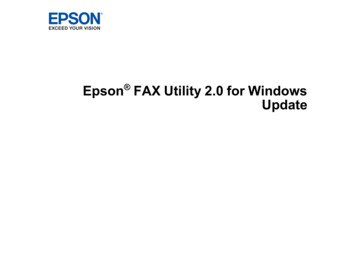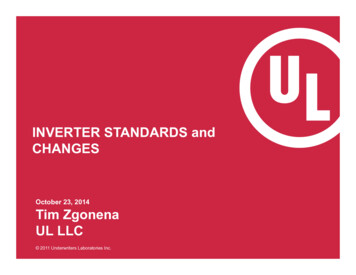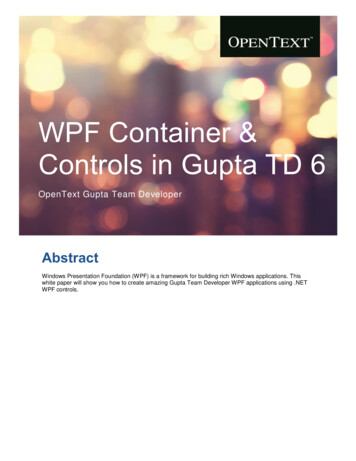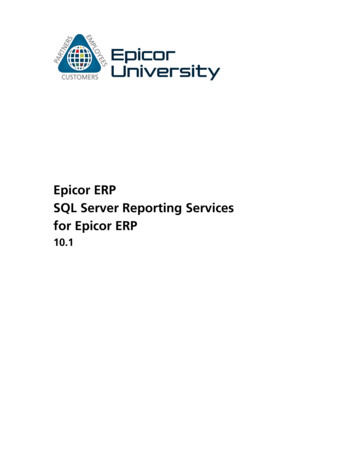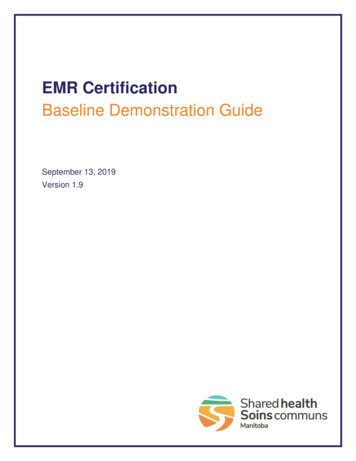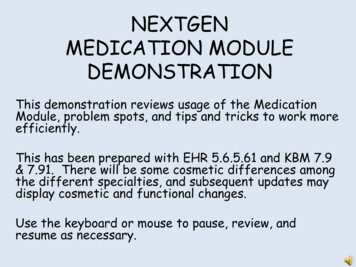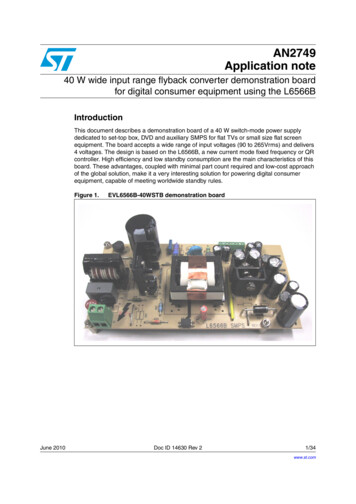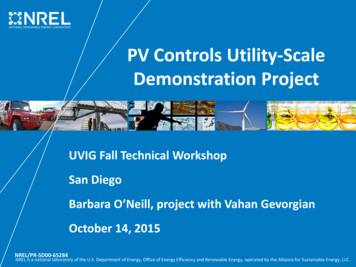
Transcription
PV Controls Utility-ScaleDemonstration ProjectUVIG Fall Technical WorkshopSan DiegoBarbara O’Neill, project with Vahan GevorgianOctober 14, 2015NREL/PR-5D00-65284NREL is a national laboratory of the U.S. Department of Energy, Office of Energy Efficiency and Renewable Energy, operated by the Alliance for Sustainable Energy, LLC.
Utility-scale PV Controls Demonstration Project Assist in removing integration barriers,mitigating reliability impacts and decreasingintegration costs Better utilization of advanced PV controls Multi-MW scale PV plant: not just energy source,but also a valuable AS provider Field testing and demonstration on a real plant,generating data to help industry2
Project Timeline and Funding All funding from DOE Solar program FY14 - 50K– Find industry partners Two industry partners (First Solar and AES) committed– Develop test plans FY15 - 300K– Perform plant controller software upgrades– Conduct tests and analyze test data– Publish test report3
Partner Selection Criteria Willingness / motivation to collaborate Plant equipment suitable for purposes of thedemonstration project– Moderate-size utility-scale PV plant (10-30 MW)– PV plant with no energy storage– PV plant with no power electronics voltage regulatingequipment (DVR, static VAR compensators, etc.)– PV plant with existing controls or easily upgradable Generate value for local grid / system operator Test results are representative and applicable tolarge variety of power systems4
NERC Task Force Recommended Controls Active power control (APC) capabilities include:– Ramp-rate limiting– Active power response to bulk power system contingencies– Inertial response– Primary frequency response– Secondary frequency response, or participation in automatic generation control– Ability to follow Security Constrained Economic Dispatch (SCED) basepoints that aresent every 5 minutesPerformance during and after disturbances– Fault ride-through– Short-circuit current contributionVoltage, reactive, power factor control and regulation (both dynamic and steady-state)5
Utility-Scale ‘Smart’ PV Plant Components Active power control– Ramp rates, controlled curtailment– Operation with reserves (contingency, ramping)– Smart variability smoothing– Frequency controlsReactive power / Voltage controlFault ride-throughShort-term forecast6
FR by Synchronous Generators Can PV generation provide similar FR? Can PV generation provide better FR?7
Project #1: AES Ilumina in Puerto Rico Puerto Rico is in a unique situation in terms of largescale PV integration Higher level of penetration anticipated in future Island system, no interconnections Reliability impacts are significant Operational challenges at any time scale PREPA already implemented many PV and windcontrols into MTRs, but there are possibilities yetuntested Use this opportunity to help PREPA address challenges8
Puerto Rico Generation CapacityTotal installed capacity: PREPA – 4,977 MW PPOA Coal and NG – 961MW PPOA Renewables – 173 MW DG and net metering – 70 MW Renewables capacity – 5.8%Evening peak: 8-9 pm2015 peak 3025 MW9
PREPA Transmission System10
PREPA Frequency Response ExampleNov 22, 2013 – 2:25am Lower inertia compared to large power systems Limited primary frequency response Small frequency bias (20 MW/0.1 Hz) implies big impact11
AES Ilumina Communication Diagram12
Tests for Ilumina PV plant Plant participation in AGCoFollow PREPA AGC signal within40% of available power Plant providing frequencydroop responseooBoth up and down-regulation5% and 3% symmetric droop Fast Frequency Response(FFR) testsoTest plant’s ability to deploy allreserve within 500 ms13
Available Power Estimation Five control sectors withindividual pyranometers Available power in �𝒔𝒔𝒔𝒔 𝑰𝑰𝒔𝒔𝒔𝒔 ��𝒔𝒔𝒔𝒔𝒔𝒔𝒔𝒔𝒔𝒔𝒔 ��𝒂𝒂𝒂𝒂𝒂𝒔𝒔 𝑺𝑺𝒔𝒔𝒂𝒂𝒂𝒂𝒔𝒔 ��𝑵𝒔𝒔𝒔𝒔𝒔𝒔𝒂𝒂𝒂𝒂 Estimated total available �𝒔𝒔 𝟓𝟓𝒌𝒌 ��𝒔𝒔𝒔,𝒌𝒌 Temperatures, inverterefficiency variations, panelsoiling not included in theformula (uncertainty source)14
AGC Test – Aug 14, 2015 (40% range)15
Plant AGC PerformanceMismatch due to errorin available powerestimationMismatch since plantreached its minimumpower setpoint (40%of available)16
Droop tests Definition of frequency droop𝟏𝟏 𝑶𝑶/𝟔𝟔𝟔𝟔𝟔𝟔𝟔𝟔 𝑫𝑫 𝑷𝑷/𝑷𝑷𝒑𝒑𝒔𝒔𝒏𝒏 Plant settings for droop testoooooo10% curtailmentSymmetric droopUpper limit – max powerLower limit – 20% belowmaximum availableDeadband – 25 mHz5% and 3% droop tests17
5% droop test – Aug 18, 201518
5% droop Test – Aug 18, 2015Period of acceptable performancePeriod of bad droop performance dueto active ramp rate limit19
3% droop test – Aug 20, 201520
Droop comparison – Aug 19 and 2021
FFR Test – High powerFast deployment of active power reserve demonstrated (within 500 ms)22
AES Ilumina Project Summary Three new controls were implemented and demonstratedon AES Ilumina 20 MW PV plant AGC tests4 days of testingAround 15 hrs in AGC mode at peak production hours (10-11am 2-3pm)o Fast and accurate AGC performance demonstratedoo FFR testooFast performance demonstratedMore control tune-ups might be necessary in futureooFast and accurate droop performance during low variabilityMore scattered performance during fast solar ramps 3% and 5% droop tests23
AES Ilumina Project Conclusions Accurate estimation of available peak power isimportant for precision of AGC control Makes sense to include specifications for suchestimation into interconnection requirements(lesser problem for plants with energy storage) System level modeling exercise will be neededto determine exact parameters of each controlfeature for maximizing reliability benefitsNREL/DOE thanks PREPA and AES teams for their assistance andvaluable contributions into this work !!!24
General Conclusions Hardware components enabling PV plants to provide full suite of gridfriendly controls are already in existence in many utility-scale plants Mainly a matter of controls and communications upgrades to fully enablethese capabilities25
General Conclusions (cont’d) Many utility-scale PV plants are already capable ofreceiving curtailment signal from grid operator; eachplant is different but it is expected to be a relativelysimple transition to AGC operation mode with just aplant controller and interface software modification Fast response by PV inverters makes it possible todevelop other advanced controls, such as poweroscillation damping PV plants without energy storage are capable ofproviding many services to the grid but marketmechanisms and/or new interconnectionrequirements are needed to incentivize curtailedoperation for any up-regulation service26
San Diego Barbara O'Neill, project with Vahan Gevorgian October 14, 2015 . NREL/PR-5D00-65284 . NREL is a national laboratory of the U.S. Department of Energy, Office of Energy Efficiency and Renewable Energy, operated by the Alliance for Sustainable Energy, LLC. . simple transition to AGC operation mode with just a

